
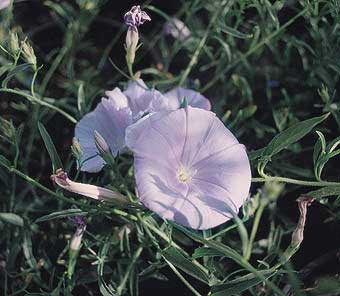 |
|||||
| Convolvulus valentinus is
the symbol of the Biological Sciences Faculty of Valencia
University. Photos by Hugh Synge |
|||||
 |
|||||
| Link to official web site for microreserves programme, or to Microhabitat site. | |||||
Botanists in the Valencia autonomous region in eastern Spain are
setting up an unusual network of micro-reserves – parcels of land of no
more than a few hectares – for their threatened plants and habitats. JOHN
AKEROYD reports.![]() e stood for a group photo on a stony plateau amongst
open woodland of juniper and pine. In a pale, wintry light, with heavy
clouds rolling in, we shivered in a chill wind and snow flurries. After
driving in convoy for several kilometres on dirt roads, we had reached our
objective, a signpost seemingly in the middle of nowhere that read
“Microrreserva de Flora”. Here in a remote part of Valencia province, 1800
m up on the slopes of Sierra de Javalambre, our tireless and exuberant
guide Emilio Laguna was showing Hugh Synge and myself from Plant Talk the
highest micro-reserve – one to protect unique juniper thickets – that he
and his colleagues have established in the Valencia Community.
e stood for a group photo on a stony plateau amongst
open woodland of juniper and pine. In a pale, wintry light, with heavy
clouds rolling in, we shivered in a chill wind and snow flurries. After
driving in convoy for several kilometres on dirt roads, we had reached our
objective, a signpost seemingly in the middle of nowhere that read
“Microrreserva de Flora”. Here in a remote part of Valencia province, 1800
m up on the slopes of Sierra de Javalambre, our tireless and exuberant
guide Emilio Laguna was showing Hugh Synge and myself from Plant Talk the
highest micro-reserve – one to protect unique juniper thickets – that he
and his colleagues have established in the Valencia Community.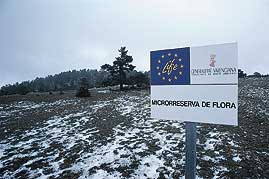 We seemed as far from the warm
Mediterranean as could be imagined, but in reality we were just 80 km from
the sea. Earlier in the week we had seen other micro-reserves on sunny
seashores, dry hills and marshlands near the coast. We had travelled
through holm and cork oak forests, matorral and arid, steppic landscapes.
It is this variety of habitat and flora, including at least 338 endemic
species, in the Spanish provinces of Valencia, Alicante and Castellón –
together comprising the autonomous Valencian region – that the botanists
behind the micro-reserve programme seek to
conserve.
We seemed as far from the warm
Mediterranean as could be imagined, but in reality we were just 80 km from
the sea. Earlier in the week we had seen other micro-reserves on sunny
seashores, dry hills and marshlands near the coast. We had travelled
through holm and cork oak forests, matorral and arid, steppic landscapes.
It is this variety of habitat and flora, including at least 338 endemic
species, in the Spanish provinces of Valencia, Alicante and Castellón –
together comprising the autonomous Valencian region – that the botanists
behind the micro-reserve programme seek to
conserve.
“Micro-reserves are a network of the total biodiversity
of the region”, Emilio Laguna told us in the more congenial surroundings
of a café in Valencia city. “They complement the larger, more conventional
protected areas – and we need both. Their legislative status too is
different. They are not strictly protected but we can upgrade the
management plans as necessary.” Micro-reserves are indeed a radical
departure from the prevailing orthodoxy of large protected areas. None is
bigger than 20 ha, most are smaller and usually no more than 1–2
ha.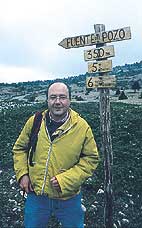
![]()
Laguna (left) is one of nature’s enthusiasts,
especially when talking about plants, and a great communicator. Plants and
botany have been his “passion” since childhood. He studied at Valencia
University, from where he received a PhD for his study of the phenology of
the Valencian holm oak woods. Since 1993 he has headed the micro-reserves
project at the Environment Department (Conselleria de Medio Ambiente) of
the regional government (Generalitat Valenciana), funded by the EU’s LIFE
programme. His nine young co-workers, who showed us around on our visit
and gave us such a warm welcome, are also able, enthusiastic
botanists.
The micro-reserves group keeps in close contact with
other botanical and conservation organizations and institutes in Valencia,
most of them under the aegis of Generalitat Valenciana. For example, the
Valencian Institute for Agronomic Research (IVIA), famed for its work on
Citrus fruits, a mainstay of the local economy, provides
micropropagation facilities for the project and the Botanic Garden of
Valencia a germplasm bank. Decentralization of government to the regions
of Spain has unleashed a flood of local pride and patriotism – a wave on
which the micro-reserves programme and other Valencian conservation
initiatives are riding successfully.
Covering the
variety
Over 140 micro-reserves have been designated so far.
Laguna plans to establish between 200 and 250 in all to cover the total
plant diversity of the region. “Many more would give us problems for
management. For this reason we are trying to encourage and include the
participation of both the private sector and municipal authorities such as
City Councils.” Already micro-reserves cover all of the 56 priority
habitats listed in the EU Habitats Directive (Annex 1) and known to occur
in the Valencia community. EU member states are required to establish
conservation areas for examples of the habitats named on Annex I and for
the sites of rare species listed on Annex II. Together these sites will
make up the ‘Natura 2000’ network.
The micro-reserves established
so far contain most of the rare and endemic plants of Valencia, but
unfortunately only a dozen or so of these are listed in the Habitats
Directive and so receive Europe-wide protection. It is clear that the list
of species on the Annex is far too small, certainly in plant-rich southern
Europe, and that the Habitats Directive fails to cover them
adequately.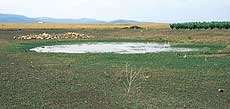 One priority for Laguna’s team is ferns:
half of the 12 plant species recorded as extinct in the Valencian
Community are ferns (including so-called fern allies). We visited one tiny
micro-reserve with two rare ferns, the larger of two temporary pools that
flood in winter and spring among arable fields near the town of Sinarcas
(right). Here grow Marsilea strigosa and a quillwort Isoetes
velata, both some 300 km from their nearest stations in W Spain and SW
France. Such pools, listed on Annex I of the Habitats Directive, are
rapidly disappearing throughout the Mediterranean region. Two other
Marsilea species are extinct in the Valencia region, one of which,
M. quadrifolia, Laguna would like to reintroduce to fields of
organically grown rice.
One priority for Laguna’s team is ferns:
half of the 12 plant species recorded as extinct in the Valencian
Community are ferns (including so-called fern allies). We visited one tiny
micro-reserve with two rare ferns, the larger of two temporary pools that
flood in winter and spring among arable fields near the town of Sinarcas
(right). Here grow Marsilea strigosa and a quillwort Isoetes
velata, both some 300 km from their nearest stations in W Spain and SW
France. Such pools, listed on Annex I of the Habitats Directive, are
rapidly disappearing throughout the Mediterranean region. Two other
Marsilea species are extinct in the Valencia region, one of which,
M. quadrifolia, Laguna would like to reintroduce to fields of
organically grown rice.
The micro-reserves do, however, include
many of the rare and endemic plants of Valencia and adjacent regions. In
the Desierto de Las Palmas Nature Park, near the coast of Castellón
province, Laguna and his colleagues took us up on to an unprepossessing
(at first sight!) rocky hillside, already drying out at the end of April.
On a former cultivation terrace, the spring flora of the matorral was
showing a final defiant burst of colour before long months of summer
drought. A proposed micro-reserve will protect a diversity of endemics and
rarities – and a paradise for the flower hunter. Among them is an elegant
storksbill, Erodium aguilellae, demonstrated to us by Dr Carlos
Fabregat, who works jointly with the Plant Biology Department of Valencia
University and Conselleria de Medio Ambiente, and who had described this
new species, a Castellón endemic flowering mainly in autumn. Other, less
restricted, endemics here include Antirrhinum barrelieri subsp.
litigiosum, Coris monspeliensis subsp. fontqueri and
Sideritis tragoriganum. Toothed Lavender (Lavandula dentata)
grows here 150 km from its nearest station, in Alicante province. More
widespread species such as a foxglove, Digitalis obscura, and a
flax, Linum narbonense, added to a colourful
display.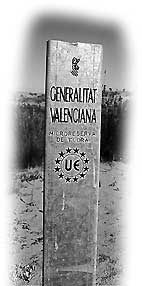
![]()
Setting up the micro-reserves
To
establish a new micro-reserve, the team first identifies a site, after
which follows perhaps a year of consultation between the Conselleria de
Medio Ambiente and experts from other institutes. The Regional Minister
(Conseller) makes the formal declaration of legal protection for both
plants and the physical habitat.
Most micro-reserves, in fact some
80%, are on public land. On private land the Valencian authorities bring
the landowner into a long-term conservation partnership. Laguna explains:
“The first stage is an agreement – a contract – with the landowner, who
receives a one-off payment. He or she can then obtain grants and subsidies
for stewardship of the site. The establishment of a micro-reserve is
legally binding, even under new ownership.” The idea of the micro-reserve
is to think local and think small. “Most micro-reserves are small”, he
says, “so the management plan is small, perhaps just a page!” It is of
course important that the area surrounding the micro-reserve is in
reasonable condition.
“About half have some degree of intervention
for conservation. The most important intervention is the reinforcement of
populations of rare plants. We may close paths in order to avoid an
excessive influx of people. Or we may carry out partial reafforestation
using local tree species to prevent soil erosion. There is usually little
‘traditional’ management because the reserves are in natural habitats. But
for example we use beehives to promote pollination, and provide nest boxes
for insectivorous birds.”
Coastal sites, subject to considerable
public pressure, can present management challenges. They also illustrate
many principles of the micro-reserves project. Prat de Cabanes Nature Park
in Castellón province (adjacent to Desierto de Las Palmas) is a complex of
coastal sand and shingle on the seaward side of extensive marshland. It is
both plant-rich and a nesting site for birds such as Montague’s Harrier,
which we saw hawking above the marsh, and Pratincole, a tern-like wader
that fortuitously flew across our path. Inland the site is hemmed in by
the coastal motorway. The shingle vegetation has a somewhat Atlantic feel,
with plants such as Sea Cottonweed (Otanthus maritimus) and Sea
Spurge (Euphorbia paralias). Further back from the strand grow
dwarf shrubs such as the white-flowered Cistus clusii, Dwarf
Fan-palm (Chamaerops humilis) and Ephedra distachya. In June
the violet flowers of Iris xiphium brighten the
marsh.
Perhaps the most special botanical feature is a population
of 22 shrubby coastal junipers, Juniperus oxycedrus subsp.
macrocarpa (with one closer to subsp. oxycedrus). These,
Laguna hopes, will be the basis for reinforcement – several female plants
bore abundant fruits for propagation – and the building up of a more
extensive population of a rare Valencian plant.
But the whole
littoral plant community excites him. “We want to make a new
micro-reserve. This type of shingle and sand is one of our rarest
geological formations. The Cisto-Lavanduletea plant community is
also rare. For example we have here Cistus crispus, mainly a plant
of Andalucia and Estramadura in southern Spain, and found no nearer than
100 km.” That the site survives at all is remarkable: this is one of the
most developed coasts in Europe. It is not far from tourist resorts like
Benidorm and its conservation is a tribute to the priorities of
Generalitat Valenciana.
Further along the seashore grew another
heterogeneous assemblage of plants. This spot too was earmarked for a new
micro-reserve. The park authorities had already closed the road to the
beach. “This area was a desert”, explained Laguna, “destroyed by visitors
and their cars. After five years the vegetation has recovered
substantially.” The proposed reserve would include the shingle-saltmarsh
transition, with Schoenus nigricans and Iris xiphium, and
(poking up amongst the pebbles, p.33) the only Valencian population of
Birthwort (Aristolochia clematitis), at its furthest south-western
limit in Europe.
Back in Valencia province, at El Saler, an area of
sand-dunes on the coast to the east of Valencia city, owned and managed by
the City Council, more drastic action has had to be taken to establish a
micro-reserve. The area is a traditional place of recreation for
Valencians and the dunes are much eroded in places. A microreserve to
protect an intact fragment of dune woodland has a chain-link fence around
it to exclude the public completely. Sadly, to allow people in would
damage the fragile soil of this unique succession from strand to mature
woodland. Entering by a small gate, we were able to walk seawards from
dense, dark woodland of low-growing Aleppo Pine (Pinus halepensis),
through Lentisc (Pistacia lentiscus) scrub to open plant
communities on accreting sand.
Involving local
communities
One of the first micro-reserves we had visited was
in Alicante province near the ancient town of Alcoi, an important centre
for textiles and dying since at least the Middle Ages. Another of Laguna’s
conservation projects is to record, and if possible conserve, ancient dye
plants such as Madder (Rubia tinctoria), as well as the other 350
or so crops formerly cultivated in Valencia (some 50 species are
cultivated today).
A magnificent forest dominated by evergreen Holm
Oak or Ilex (Quercus ilex subsp. rotundifolia) covers a
mountain ridge to the south of the city, on what is the most
north-easterly extension of the Baetic Mountains of Andalucia. Other major
trees include Portuguese Oak (Q. faginea), Manna Ash (Fraxinus
ornus) and Acer granatense. In 1987, the Generalitat Valencia
established the 2450-ha Natural Park of Carrascar de la Font Roja. But
back as far as 1332 the City Council of Alcoi had protected the forest. As
Laguna says, “Local people feel the area is a part of themselves, and so
take care of the forest.” It therefore makes an ideal site for a
micro-reserve, quite apart from being one of the most outstanding
old-growth forests in Spain. It is perhaps the nearest equivalent to
Spanish primeval dry evergreen oak forest that still remains.
The
micro-reserve, at 1350 m, is a fine representative sample of this
community, and also includes endemic plants of open rocky ground like
Iberis carnosa subsp. hegelmaieri and Centaurea
boissieri subsp. mariolensis, and more northern floristic elements
such as Yew (Taxus baccata). Font Roja is the only mountain in
Alicante province to remain wooded. The others are too arid or have been
denuded by too many fires.
Two days later we were up in the mists
and cold of Sierra de Javalambre. This area of Valencia province, although
a detached enclave between La Mancha and Teruel provinces, is proud to be
the most ancient part of Valencia, captured from the Arabs early on in the
Reconquista. The juniper forests themselves are a link with Spain’s
legendary freedom fighter El Cid, for the open woodland allowed his
cavalry both concealment and mobility. On the arid hillsides of Javalambre
isolated trees or clumps of the upright Spanish Juniper (Juniperus
thurifera) are often surrounded by prostrate thickets of Savin (J.
sabina), producing a characteristic ‘leopard-spot’
vegetation.
Forestry experts have estimated the very largest
Spanish Juniper trees to be of immense age. Luis María Alcusa, mayor of
the adjacent community of Puebla de San Miguel, is proud of the trees and
of the well-preserved mountain forests – owned by the City Council – about
his village. “We do not know exactly which is the oldest”, he told me as
we admired a group of huge junipers near a spring, “but these five trees
are between 1500 and 2000 years old. The secret is that perhaps few people
lived here and they were very poor. We are going to make this spot a
micro-reserve, probably this year, which will be funded by the Regional
Programme.” Puebla de San Miguel is developing its potential for
ecotourism, for example by refurbishing tiny shepherds’ huts for the use
of walkers and riders. An old winery in the village has been restored as a
museum of rural life. Already sustainable development for tourism has
created jobs and breathed new life into a once declining community ‘at the
end of the road’.
A blueprint for the future
The
young, enthusiastic and confident Valencia team is justifiably pleased
with the progress of the micro-reserves project. And, although the
reserves do not have quite the status of, say, a National Park,
co-operation with managers of existing protected areas and the goodwill of
local people will clearly play a considerable role. It will be important
too to make sure that each site remains buffered by an environmentally
healthy hinterland.
Emilio Laguna sees the micro-reserves network
as the first step towards eventual expansion – building blocks for a
larger network. “The immediate purpose of the micro-reserves is not strict
protection, but to create a network of biodiversity – a framework for the
future. And it is a chance to experiment with the techniques of plant
conservation and reintroduction.” One hopes too that the micro-reserve
programme provides a stimulus and example to other regions of Europe and
the world. It certainly makes sense in regions like southern Europe that
are rich in local endemics, often in small, scattered and restricted
populations. And everywhere it is getting harder to find larger
species-rich areas to protect.
John Akeroyd and Hugh Synge were
guests of Conselleria de Medio Ambiente de la Generalitat Valenciana and
Empresa de Tranformación Agraria (TRAGSA).
Dr Emilio Laguna can
be contacted at Generalitat Valenciana, Conselleria de Medio Ambiente,
Arquetecto Alfaro 39, 46011 Valencia, Spain.
E-mail:
emilio.laguna@cma.m400.gva.es
A feature article reprinted from Plant Talk No 14 (July 98)

Home | Aims | Latest issue | Past issues | Stories
Subscribe Now |
Meetings | Plant Facts | Resources
©
Plant Talk
July 1998
